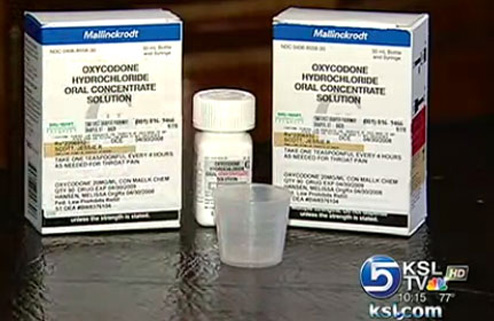Wal-Mart pharmacist’s error sends teen into coma
No matter how much we try to protect ourselves from unsafe drugs and pharmacy practices, errors can and do occur. The Consumerist reports that a Utah teen was in ICU for 16 days after a Wal-Mart pharmacist gave him the wrong prescription for his strep throat.
Jessie Scott’s doctor had ordered a liquid solution of oxycodone hydrochloride to treat Scott’s pain — but the pharmacist gave him a concentrated solution, which caused Scott to consume 20 times the prescribed dose of the medication.
Ultimately, we have to trust our pharmacists — online or off — to do what they’ve been trained to do. But I would add that in my experience, when a liquid medication is concentrated — as stated on the box label, above — it calls for being diluted. This should be enough of a red flag to double check with the doctor before taking the medication.
I’m not saying this to criticize the victim in this case; what happened to him is absolutely inexcusable. But we should always try to learn from instances like this.
One of the messages I’ve been trying to communicate since I started this blog nearly two years ago is that, ultimately, you’ve got to look out for yourself when it comes to your health. Because no one cares as much about it as you do.
Related Posts
-
 Merck and insurance companies at cross-purposes over Gardasil
Merck and insurance companies at cross-purposes over Gardasil
- What’s safer — online pharmacies or Wal-Mart?
-
 How do you know you can trust an online retailer?
How do you know you can trust an online retailer?
- Do You Need a Prescription for Online Canadian Pharmacies?
- Survey: Teens who abuse prescription drugs don’t buy them on the Internet
- How to Evaluate Online Pharmacies







6 Responses to Wal-Mart pharmacist’s error sends teen into coma
Leave a Reply Cancel reply
-
 Subscribe in a reader
Subscribe in a reader -
-
Ads

-
How to Safely Buy Prescription Drugs Online from Cary Byrd on Vimeo.
-
Medi-Share: Christian Health Insurance Alternative

-
Search Blog Posts
-
Blogroll
- Boerne Church
- Boerne website design
- Bullet Wisdom
- Bulverde Church
- Christian Social Network
- DrugWonks.com
- Eye on FDA
- Health 2.0
- Kevin, M.D.
- Pharm Aid
- Pharma Marketing
- PharmaGossip
- Pharmalot
- River Crossing Homes for Sale
- San Antonio Asphalt
- San Antonio Life Insurance
- San Antonio Pressure Washing
- The Health Care Blog
- The Peter Rost Blog
- Watch Christian Videos
- World Vision
-
Our Healthcare100 Ranking
-
Archives
-
Tags
adverse drug reactions Affordable Care Act big pharma Canadian drugs canadian pharmacies canadian pharmacy compare drug prices consumer reports Dave Ramsey discount drugs divine healing Drug costs Drug Importation Drug Prices eDrugSearch.com FDA Fosamax healing scriptures Health 2.0 health blog directory health blogs healthcare100 healthcare reform Hypertension Jehova Rophe Jesus Christ Lipitor Medi Share miracles Obamacare online pharmacy dictionary osteoporosis Pharmacies pharmacy spam Prescription drugs promote health blog Proverbs 3:5-8 reimportation relenza Roche saving money submit health blog Tamiflu The Great Physician The Lord our Healer

So does anyone now how this young man is doing?
Oxycodone for step throat pain? What are we thinking?
[...] Does anyone buy this argument? If so, remember: There is not, to my knowledge, a single documented instance of a U.S. consumer being harmed by the wrong drug, or an adulterated drug, shipped by a properly licensed Canadian pharmacy. This is pretty amazing — especially when you consider that even U.S. pharmacies make mistakes from time to time. [...]
jesse scott is my cousin i visited him this spring break and he is in stable condition and is improving. although he cant move (exept his fingers without controll) he is not exepected to walk again. but on the bright side they are sueing them for a lot of money. but the amount is undecided.
As a pharmacist that studies medication errors and specializes in the design of processes to prevent them, I wanted to add a couple of comments:
1. This medication is not supposed to be diluted. There are concentrated formulations to allow those patients that are highly tolerant to the effects of the medication – like a cancer patient might be – to take reasonable amount. For example, a patient that is not usually on this type of pain medication may take 5ml of the normal concentration. A highly tolerant cancer patient – one that needed the 20x stronger strength – would have to take 100ml of the normal concentration to get the pain control they require. The concentrated medication allows the highly tolerant patient to take a reasonable amount – 5ml.
2. As long as there are humans in the system, there will be errors. There are a number of dangerous things that we do that – even with focus – can go wrong with a simple human error. Most drivers remember a time, at some point, where they realized they accidentally ran a stop sign. Search the internet for babies in cars, and you will find hundreds of ‘hits’ where a person accidentally left a baby in the back of a car on a hot summer day, only to realize the error when it was too late. Compared to all of the babies in cars, it is a very very small number, but it demonstrates that humans do err, even with the thing they find most precious. Consider that if a pharmacist is filling 350 prescriptions a day, that is 1750 filled in a five day work week. At a 99.9% accuracy rate, there will still be 2 errors per week. Humans aren’t anywhere near 99.9% accurate, no matter how careful, how highly trained, or how competent they are. You cannot educate perfection or educate away human falliability. Thankfully, most errors do not result in tragic outcomes, as it did with this case. My thoughts are with the boy and his family, with the hopes of a rapid and complete recovery. I hope that his young age helps him recover further than the physicians predict.
3. The human mind tries to balance the consequence of an error with the severity of an error. For example, consider if you accidentally run a stop sign an no one gets hurt. Consider the same error – accidentally running a stop sign – and someone gets killed. It is the same error in both situations – that is, it is the same failure of the human mind – but the consequences are different. That’s why design of processes to assume that these errors will always occur – and to try to capture them before the reach the patient – are key to patient safety.
[...] may recall that last year, a Wal-Mart pharmacist’s error sent a teenager into a [...]